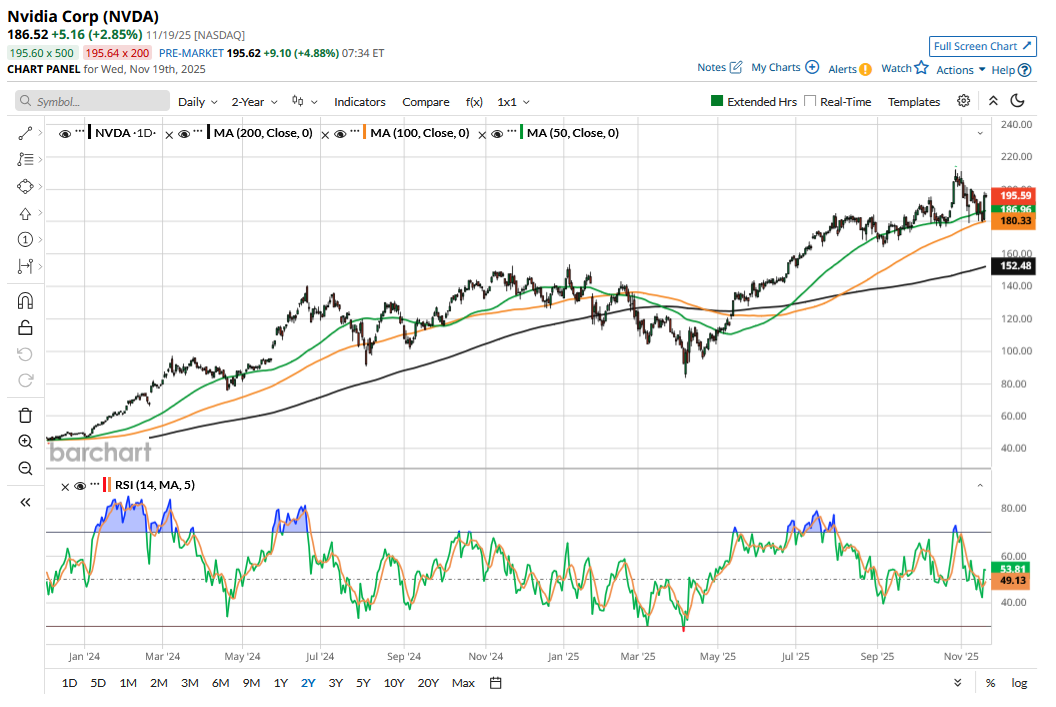Nvidia (NVDA) released its fiscal Q3 2026 earnings yesterday, Nov. 19, after the markets closed. The company beat earnings hands down, not that the market expected anything else from the Jensen Huang-led company.
Nvidia’s earnings came at a time when the rally in artificial intelligence (AI) stocks was getting tested. Michael Burry of “The Big Short” fame has become a flag bearer of sorts for the “AI bubble” narrative. During Nvidia’s Q3 earnings call, Huang began his commentary by addressing apprehensions over the feared AI bubble by saying, “From our vantage point, we see something very different.” So, has Burry—who correctly predicted the 2008 U.S. housing crisis—gotten it wrong this time around? Let’s explore.

Nvidia’s Order Books Have Swelled
Nvidia is at the center of the AI revolution, and the company’s GPUs are powering the AI ambitions of tech giants. Let’s look at a few numbers. In fiscal Q3, the quarter-over-quarter (QoQ) increase in Nvidia’s revenue was $10 billion, which, for context, is higher than the total quarterly revenues it used to post before AI really took off.
At last month’s GTC, Nvidia touted orders worth $500 billion for its AI chips between 2025 and 2026. During the Q3 earnings call, CFO Colette Kress said there is “definitely an opportunity for us to have more on top of the $500 billion that we announced,” pointing to the partnerships with Saudi Arabia and Anthropic in recent days.
The company expects gross margins to hold in the “mid 70s” in the next fiscal year, which would mean billions of dollars in real profits and cash flows. While there have been comparisons between Cisco’s (CSCO) price action in the dot-com days and Nvidia’s rally in AI trade, they miss the point about the commensurate, or perhaps more than adequate, growth in Nvidia’s earnings. Consider this: Nvidia currently trades at a forward price-to-earnings (P/E) multiple of under 44x, which is not expensive compared to what the stock traded for before the AI boom took off in 2023.
There are headwinds in the form of loss of China business and emerging competition, including from Chinese companies, but as I noted previously, NVDA stock could still be a winner even if the company loses its monopolistic position in the AI chip market.

Nvidia Addresses “AI Bubble”
During Nvidia’s Q3 earnings call, there was a lot of focus on AI monetization and how different companies are reaping the rewards of their AI investments. In what I find slightly unusual, Kress also listed the recent financial numbers from OpenAI and Anthropic to highlight that AI capex is no vanity project and companies in the space are seeing unprecedented growth.
The management sought to dispel concerns over the AI bubble, with Huang saying, “Transition to generative AI is transformational and necessary, supercharging existing applications and business models.” He added that “the transition to a genetic and physical AI will be revolutionary, giving rise to new applications, companies, products, and services.”
Is AI a Bubble?
That said, I believe the concerns over AI eventually entering the bubble zone are not unfounded, as tech giants continue to pour money into AI infrastructure as if there's no tomorrow. There are also concerns over tech companies’ ability to generate adequate return on their AI capex, even as the early monetization trends are healthy.
Like every other emerging industry, we can be reasonably sure of an eventual bubble in AI, too. The most recent example I can think of is the electric vehicle (EV) space, whose bubble has burst, and once-high-flying companies commanding valuations in tens of billions of dollars have gone bankrupt.
There were signs of a possible bubble as loss-making EV companies with a fraction of the revenues of legacy automakers commanded market caps north of $100 billion. At its peak in 2020, Nikola (NKLAQ) was valued more than Ford (F), even though the company hadn’t yet started delivering cars.
For me, the biggest sign of an EV bubble came in September 2020 when a little-known energy company, SPI Energy (SPIEF), soared 4,000% after announcing the launch of an EV subsidiary. Making cars is no easy nut to crack, and EV startups learned it the hard way.
Would we see something similar in AI? Looking at valuations of some of the unlisted players, I do sense exuberance, as the kinds of valuations startups with little (albeit fast-growing) revenues are commanding are just mind-boggling. The listed space is looking prettier, though, as, unlike the dot-com era companies, today’s tech giants have rock-solid balance sheets with real cash flows and earnings to back up their valuations.
To sum it up, I don’t share Burry's pessimism towards Nvidia and other tech names, as AI is set to redefine numerous things, just as the internet did. While AI might get into a bubble zone sometime in the future and not all AI plays would create wealth for investors, for now, I would continue betting on AI stocks.
On the date of publication, Mohit Oberoi had a position in: NVDA , F . All information and data in this article is solely for informational purposes. For more information please view the Barchart Disclosure Policy here.
More news from Barchart
- Wall Street Is Betting on Nuclear Energy, But Legendary Investor Peter Thiel Just Ditched This 1 Key Power Stock
- With $1.6 Billion in Jeopardy, Should You Buy, Sell, or Hold Plug Power Stock Here?
- Is the S&P Technically Not Bullish Now?
- As Nvidia Stock Soars Following Q3 Beat, Will Michael Burry Bite the Dust?






